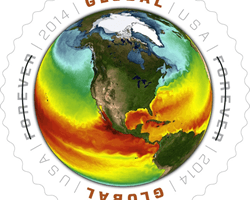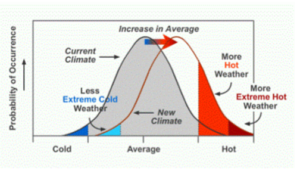Delivery complete or return to sender? Protecting a legacy

How can the USPS protect its core business by mitigating the risk of climate change?
For over two hundred years, the United States Postal Service (USPS) has been providing “trusted, affordable and universal mail service to the people of the United States.” [1] The importance of USPS’s ability to fulfill this mandate is critical to its success and longevity of its business. Overtime, the USPS has developed its business practices to respond to an evolving landscape, including being responsive to key threats such as climate change. Greenhouse gas buildup, a result of global climate change, is contributing to a warmer planet, leading to profound changes in the environment. Impacts include the frequency, intensity, and duration of inclement weather, sea level variations, precipitation increases, and rising temperatures. [2]
Climate change is increasing the likelihood of warmer and more extreme weather.
Changes in weather patterns can hinder the USPS from satisfying its core customer promise of delivering mail, while significantly increasing the costs of fulfilling demand and maintaining the infrastructure needed to run its business. [2] These environmental changes have the ability to impact the USPS throughout its delivery chain: from its employees to its fleet of vehicles, from transportation infrastructure to its inputs.
Extreme weather can endanger employees who are up against tight delivery deadlines. And these impacts are costly. Severe weather led to 679 widespread power outages between 2003 and 2013, costing the economy $33 billion each year. [5] For a business whose employees drive more than 1.4 billion miles every year, transportation is a significant risk for the USPS. [4] Flooding can impact infrastructure by weakening bridges, destroying roads, and interrupting repairs. Heat can affect aircraft performance, causing delays and hiking transportation costs. At a macro level, regulations could shock the entire system. New laws that control greenhouse gas emissions, for example, may increase operating costs (i.e. more expensive fuel products or costs from retrofitting vehicles). [6]
Luckily, the USPS has been proactive in addressing the issue of climate change, as evidenced by its 2014 Climate Change Adaptation Plan. In it, the USPS identifies and begins to implement risk measurement practices and strategic plans aimed at combating climate change. These include:
- Creating a multi-disciplinary task force to identify, plan for, and implement business resilient practices to climate change. [2]
- Setting a greenhouse gas emissions reduction goal of 20 percent between 2008 and 2020. [7]
- Implementing fuel efficiency standards for its fleet of delivery vehicles. [8]
- Reviewing its real estate plan to assess how its current and future facility locations may be optimized or altered to reduce the risks from climate change. [9]
- Reassessing the use of underground tanks for gasoline and diesel fuel storage and modernizing tank infrastructure. [1, 4]
- Implementing an annual review of the company’s exposure to climate change. [2]
Results thus far have been mixed. More positively, the USPS has cut greenhouse gases by 12.4% since 2008, and in 2015 alone, it performed over 1,500 compliance inspections for tanks. [10, 4] Additionally, since 2003, it has reduced facility energy use by 32.1%. However, the USPS has been unable to stem its reliance on petroleum use, which has increased by 19% in the past decade. [4]
This begs the question, is the USPS doing enough? With the great deal of uncertainty that is expected to materialize as a result of climate change, the USPS must employ strict controls and risk measures to ensure business continuity. They will need to invest in the right technology to better optimize shipment processes, allowing for reduced transport times. Additionally, it will be critical to reinforce strong cost management practices to protect its business from pressures to come. While the USPS has begun partnering with sustainable companies, and has even reduced its costs by $8BN over the past 2 years, it has ended FY 2013 and 2014 with net losses of over $5BN, respectively. [11] In order to remain competitive, the USPS will need to improve its ability to manage costs while generating significant revenue growth. One example could be relying more on electric vehicles to power its fleet. An electric vehicle can travel 43 miles for every $1.00 of energy versus 18 miles for a traditional vehicle. [12] Finally, stress testing its operations will allow the USPS to be better prepared in the face of uncertain outcomes.
Only through strong preparation will the USPS be able to continue its over 200-year legacy of reliable and timely mail delivery.
[Word Count: 724 words]
Cited Sources:
[1] Sarah Ninivaggi, “USPS Goes Green,” (21 April 2015), accessed 31 October 2016, https://uspsblog.com/usps-goes-green/
[2] “United States Postal Service Climate Change Adaptation Plan,” (June 2014), accessed 31 October 2016, https://about.usps.com/what-we-are-doing/green/pdf/CCAP_FINAL_2014.pdf
[3] “Understanding the Link Between Climate Change and Extreme Weather,” US Environmental Protection Agency (last updated 19 October 2016), accessed 1 November 2016, https://www.epa.gov/climate-change-science/understanding-link-between-climate-change-and-extreme-weather
[4] “2015 Annual Sustainability Report,” United States Postal Service (2016), accessed 1 November 2016, http://about.usps.com/publications/sar2015/sar2015.pdf
[5] Justin Sink and Jim Snyder, “Energy Review Warns of Rising U.S. Costs from Climate Change,” Bloomberg News (21 April 2015), accessed 1 November 2016, http://www.bloomberg.com/news/articles/2015-04-21/white-house-unveils-road-map-for-upgrading-energy-infrastructure
[6] “United States Postal Regulatory Commission 2015 Report on Form 10-K” (30 September 2015), accessed 2 November 2016, https://about.usps.com/who-we-are/financials/10k-reports/fy2015.pdf
[7] “2016 Climate Leadership Award Winners” US Environmental Protection Agency (last updated 23 March 2016), accessed 2 November 2016 https://www.epa.gov/climateleadership/2016-climate-leadership-award-winners
[8] “Greening Our Fleet,” United States Postal Service, accessed 3 November 2016 https://about.usps.com/what-we-are-doing/green/greening-our-fleet.htm
[9] Kate Sheppard, “U.S. Postal Service Is Worried About What Climate Change Will Mean For Mail,” Huffington Post (31 October 2014), accessed 3 November 2016 http://www.huffingtonpost.com/2014/10/31/mail-climate-change_n_6085108.html
[10] “2015 U.S. Postal Service Key Performance Indicators,” United States Postal Service, accessed 3 November 2016 http://about.usps.com/publications/sar2015/sar2015/sar2016_doc_001.htm
[11] “Restructuring the U.S. Postal Service to Achieve Sustainable Financial Viability,” U.S. Government Accountability Office, accessed 3 November 2016 http://www.gao.gov/highrisk/restructuring_postal/why_did_study#t=0
[12] “How Do Gasoline & Electric Vehicles Compare?” Idaho National Laboratory, accessed 4 November 2016 https://avt.inl.gov/sites/default/files/pdf/fsev/compare.pdf
Featured Photo: http://about.usps.com/news/national-releases/2014/pr14_027.htm





Hey Samantha thanks for the read! After researching and writing about UPS, I was quite interested to see the similarities and differences between the two parties. I believe both organizations could learn from each other. For instance, I really like USPS’s partnering with sustainable companies to create value for both parties. And for USPS’ learning, UPS has already launched and experimented with different types of alternative fuel vehicles under various geographic conditions.
Great article! Now I’ll have to go read Chris’ to compare and contrast a company vs. an agency’s response to similar problems. What is really interesting to me is how USPS can address these issues in the face of operating losses, as you mentioned. I’d imagine that they are under massive pressure to find new sources of revenue and increase existing sources, particularly as a network system like this experiences significant volume benefits. There might be a conflict of interest between 1) needing to raise volume and revenues in order to continue to exist, 2) acting as a federal agency established to meet citizen needs rather than a for-profit company, and 3) reducing overall environmental impact and improving resiliency. USPS has a tough challenge ahead of them – good thing we are graduating lots of smart minds who are keen on tackling our public sector challenges!
I found this article really interesting because I’m fascinated with paper and think there could be a world where physical paper is the exception and not the rule. After reading this article, a couple of things stood out to me:
1) It will be very challenging for the USPS to manage its mandate and execute on this – I agree with Margaret’s comment above highlighting the potential conflict of interest within the USPS
2) I wonder what will happen if paper mail volumes continue to decline and revenues fall more dramatically. Revenue for the USPS has declined by 5.3% over the past 10 years [1]. Paper mail volumes are decreasing – packages are only a very small percent (6.5%) of their overall shipping volume. Advertising mailings are over 50% of volume and have declined by 20% over the past 10 years – ad dollars are shifting to digital platforms. I predict this trend continues going forward and digital will continue to draw ad dollars away from traditional sources. I think that as tablets become more ubiquitous and millennials and gen z, who are digitally native, age – the concept of a paper mailing or bill will become foreign. If the USPS’s revenue declines even more dramatically over the next 10-20 years, how will they be able to justify spending on environmental efforts? How will these efforts be balanced with an effort to stay afloat and viable?
[1]https://www.uspsoig.gov/sites/default/files/document-library-files/2015/rarc-wp-15-010_0.pdf